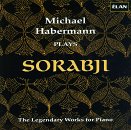A premiere Sorabji interpreter here
scarecrow | Chicago, Illinois United States | 05/07/2000
(5 out of 5 stars)
"Sorabji had placed a ban on all public performances of his music. This was an integral part of his aesthetic and philosophic view. I don't know if it was consistent with the Zorastrian faith from his father's lineage,his father being Parsi. Habermann however was one of the first pianists to be given authorization by Sorabji to play his piano music after the ban was lifted,for which he did in New York at Carnegie Hall.Here two Sorabji nocturnes are included,two of the most beautifully sounding works. Sorabji's music can sound overbearing,predictable and ugly at times relativily speaking with closely positioned triads, unvoiced bass register chords which only contribute to the overall density of his vast oceanic constructions.These sonorities also usual unflod within a short span of time,so the overtones are always overtaxed,overly superimposed, almost as if the chords are piled up onto each other blurring the sonic clarity. But here the noctures,there seems to be greater sonic freedom of the large phrase, a sound is allowed time to ring harmoniously, to spend itself toward a full natural decay. These chordal events usually begins in the lower resiters of the piano,densily packed chords, then as the phrase scales upwards more ornaments are added and an accretion occurs in the sound as the time unfolds. This music can sound quite free, almost like gentle wind chimes swaying breezes. Gulistan or Rose Garden refers to the prose of the Sufi Persian poet Sa'di (1213-12-91), the poem which Sorabji adopts at some distance for he was not a tone painter. The poem is about detachment. Likewise the other nocturne "Djami"(1928) engages another poet Nuru'd-Din Abdu'r-Rahman Jami (1414-1492). Here the music inhabits more open spaces, with single sonorities without subsequent ornament, but then reveals a great deal of density toward the end.. The change of pianos here is fascinating, for Habermann had recorded this CD at different venues.What is interesting is in that pianistic timbre is an important realm within the Sorabji edifice of expression, and in many ways help define a particualr interpretation.The pianist Geoffrey Madge speaks more on this point., The Gulistan was performed on a Steinway, and that instrument had a balanced compact constitution, where the high degree of ornamentations seems to emanate from one source, there is no dramatic separation of timbral say between the middle registers and the extrems higher,so the Steinway is more controlled. In contrast the Fantasietta sul nome illustre dell'egregio poeta Christopher Grieve ossia Hugh M'Diarmid (1961) was performed on a Mason & Hamlin which had an incredibly brighter timbre in the upper register,where this register seemed detached from the rest of the keyboard. Much control is necessary to balance here,and Habermann really doesn't consciously attempt this balance. That work a mere two an one-half minutes was a hommage to the Scottish poet Hugh MacDiarmid. On the Gulistan,likewise Habermann plays with much sonoric freedom, not being tyrannicized by the density here, many times he allows the pianisitic colours to blur beyond what the image of the work suggests I thought. Charles Hopkins also has recorded the Gulistan, and I prefer Hopkins with more a sense of discipline, and timbral shape.The piece based on a ghost story Quaere reliqua hujus materiei inter secretiora (1940) is more a traditionally bound work, with repitition of ideas, and more predictable placement of melodic materials.Here although not a tone painter within the Western canon, still Sorabji suggest the other-wordly with organ-like chords in a successive rhythm almost Messiaen-like. The Feurich piano had an inferior sound relative to the other works timbre on this disc.And the result was withou a timbral focus. There are passages as in this ghost work where the lower regions of the piano are utilized merely to create a sound, much like a gong, or tam-tam,no intervallic clarity is required."


 Track Listings (5) - Disc #1
Track Listings (5) - Disc #1